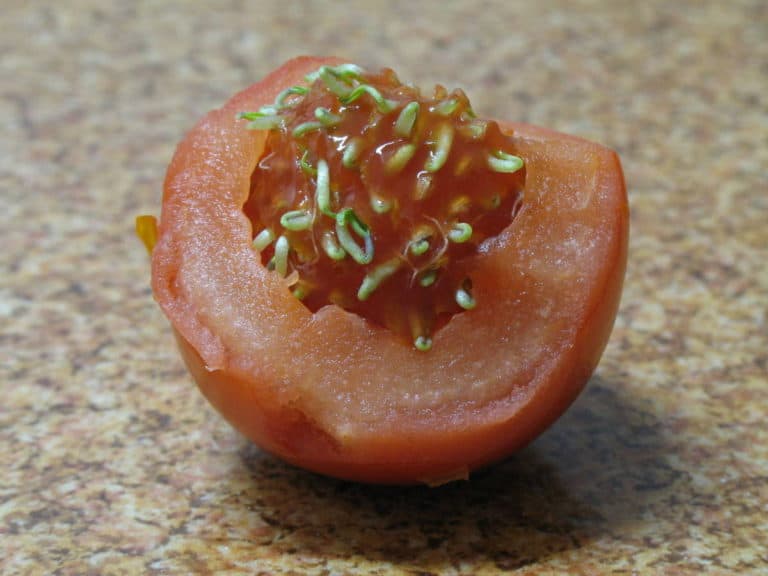Have you ever sliced open a tomato and been startled to see little sprouts emerging from seeds inside? This strange phenomenon has a name – vivipary. Here’s an explanation of what causes seeds to sprout prematurely inside tomatoes, what vivipary means, and whether these sprouted tomatoes are still safe to eat.
What is Vivipary?
Vivipary is when seeds begin to germinate and grow while still attached to the parent plant. The term comes from Latin words meaning “live birth.” With tomatoes, it means the seeds start sprouting and growing baby tomato plants while still inside the tomato fruit.
This happens most often when tomatoes are left to ripen for too long Normally, an inhibitory hormone in the gel surrounding the seeds prevents early sprouting But over time, ethylene production and enzymes break down this hormone, allowing the seeds to germinate inside the over-ripe fruit.
Why Does Vivipary Occur in Tomatoes?
There are a few key reasons why tomato seeds may begin premature sprouting
-
Over-ripening – Tomatoes left to ripen for too long on the counter lose the hormone that keeps seeds dormant.
-
Cold exposure – Temperatures below 55°F can trigger seeds to sprout inside.
-
Low ethylene – Ethylene is the ripening hormone in tomatoes. Low levels prevent full ripening and seed dormancy.
-
Enzyme action – Enzymes in an aging tomato degrade the inhibitors that prevent vivipary.
-
Variety susceptibility – Some tomato varieties, like heirlooms, are more prone to vivipary.
The main factors are over-ripening and cold temperatures. Even short-term refrigeration can cause vivipary. The seeds perceive the cold as winter, breaking dormancy.
Is it Safe to Eat Sprouted Tomatoes?
Tomatoes with internal sprouts are still perfectly safe to eat. The sprouts are young tomato seedlings starting to grow, not mold or anything harmful.
However, sprouted tomatoes may taste more bland or mealy in texture. The germinating seeds use up sugars and other compounds, robbing the surrounding fruit pulp of flavor. The texture also suffers as enzymes break down pectin and cell walls during sprouting.
So while vivipary doesn’t make tomatoes poisonous, it does degrade taste and texture. It’s better to catch your tomatoes before they overly ripen and sprout.
How to Prevent Vivipary in Tomatoes
To reduce the chances of seeds prematurely sprouting, follow these tips:
-
Pick tomatoes at peak ripeness before over-ripening sets in.
-
Store at room temperature, not refrigerated. Cold triggers vivipary.
-
Use within 2 weeks for maximum flavor and to prevent sprouting.
-
Choose less susceptible varieties like modern hybrids.
-
Avoid drastic temperature swings which can confuse seeds.
-
Prevent ethylene build-up by avoiding overcrowding during storage and ripening.
-
Consume cut tomatoes within a few days and keep refrigerated.
What to Do with Sprouted Tomatoes
If you end up with viviparous tomatoes, here are some options:
-
Use in cooked dishes like sauces, soups, stews where texture isn’t as important.
-
Blend into smoothies, juices, gazpacho. The seeds get pureed away.
-
Compost them if the texture is too far gone.
-
Extract the sprouts and try planting them! Some may grow into seedlings.
While abnormal looking, sprouted tomatoes don’t pose any safety risk. Vivipary is a natural, if odd, phenomenon triggered by tomatoes aging past peak ripeness. Storing tomatoes properly and using within 2 weeks minimizes the chances of cutting into a tomato full of surprise sprouts!
What Does Vivipary Look Like?

Depending on the type of fruit, how many seeds have sprouted, and how much they have grown, vivipary will look different. No matter what, if you’re unfamiliar with it, it can seem creepy.
When tomato seedlings grow through the fruit wall and continue to grow outside the fruit, they can make the fruit look very strange. Some people think it’s an invasion of thin green or white worms or a mutation, but it’s not.
Vivipary is just mature seeds within fruit doing what comes naturally in the right conditions.
This shows how to save seeds from tomatoes for future sowing.
Are Sprouting Fruits Safe to Eat?
If there is nothing else wrong with the fruit, having a seed or seeds sprout inside a fruit like a tomato or pepper is not a problem.
Larger seeds like avocado (do not eat avocado seeds!) and mango should not be consumed regardless.
Tomato seeds sprouting inside the Tomato! Why?
FAQ
Can you still eat a tomato with seeds sprouting inside?
Is it safe to eat tomatoes with vivipary?
What to do with sprouted tomato seeds?
Are volunteer tomatoes safe to eat?
- A Complete Guide to Caring for Yuki Cherry Blossom Shrub - January 23, 2025
- Identifying Red Hot Poker Seeds: What to Look For When Harvesting Torch Lily Pods - January 23, 2025
- A Complete Guide to Harvesting Evening Primrose Seeds - January 23, 2025

